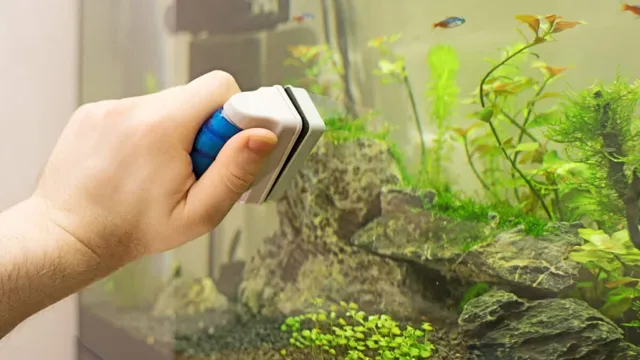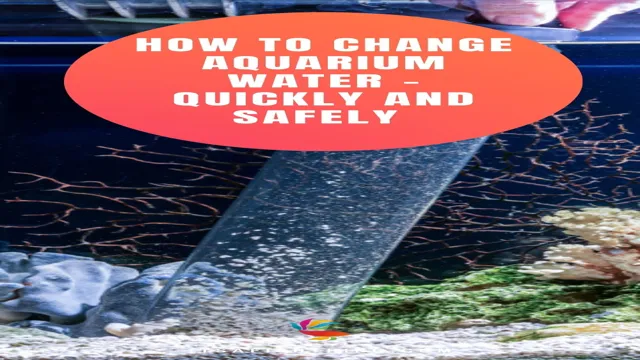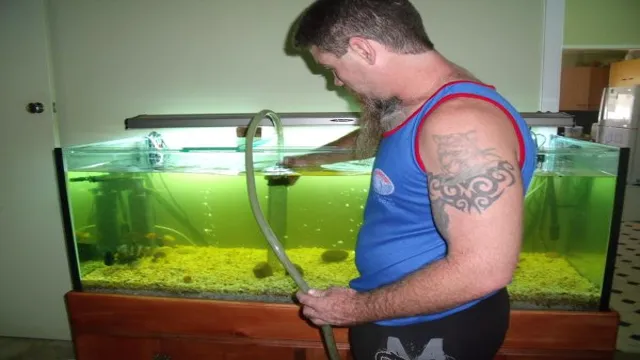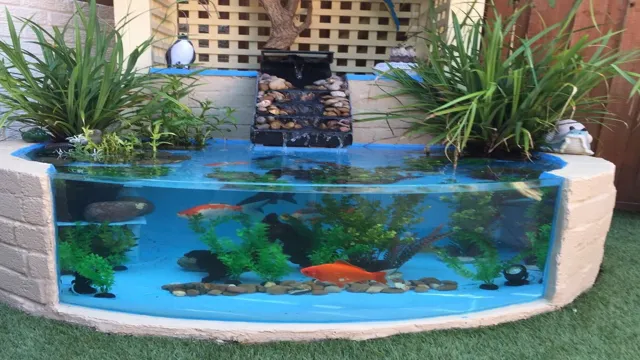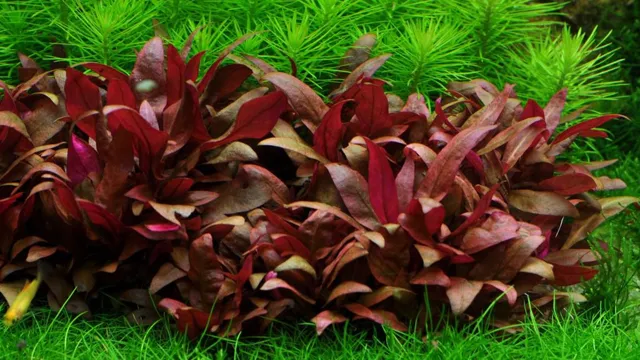Keeping a saltwater aquarium can be an incredibly fulfilling and rewarding hobby. However, maintaining a healthy and beautiful aquarium can also be a lot of work. One of the most common issues faced by aquarium owners is the growth of annoying and unsightly algae on the glass.
Not only can it be aesthetically unpleasing, but it can also harm your plants and marine life. But don’t worry, cleaning algae from saltwater aquarium glass isn’t as daunting as it may seem. With a little bit of knowledge and effort, you can get your glass sparkling clean in no time.
So, let’s dive in and explore some effective ways to eliminate this pesky problem!
Understanding Algae Buildup
If you have a saltwater aquarium, you may have experienced the frustrating issue of algae buildup on the glass. Algae is a common problem that occurs when there is an excess of nutrients in the tank, such as excess lighting and overfeeding. To clean algae from your aquarium glass, you can use a variety of methods.
One effective method is to use a magnetic glass cleaner, which consists of two magnets with a soft cleaning pad attached to each side. Simply place one magnet inside the tank and the other on the outside, and move it around to clean the glass. Another option is to use a scraper tool designed specifically for aquarium glass.
Be sure to use caution when using a scraper, as too much pressure can scratch the glass. It’s important to regularly clean your aquarium to prevent algae buildup and maintain a healthy environment for your aquatic pets.
Types of Algae
Algae buildup is a common issue that affects many bodies of water or surfaces exposed to moisture. Different types of algae can grow in various aquatic environments, ranging from the green film that covers aquarium glass to the slimy mats that spread across a lake’s surface during warm weather. Understanding the types of algae buildup is crucial for proper identification and treatment.
Some types of algae are harmless, while others can be harmful to aquatic life and human health. For instance, blue-green algae, also known as cyanobacteria, can release toxins that cause skin irritation, respiratory problems, and illness if ingested. Therefore, it’s essential to take measures to prevent or control algae growth, such as reducing nutrient levels, improving water circulation, adding beneficial bacteria, or using algaecides.
By knowing the types of algae and their characteristics, you can determine the best approach to remove or prevent them and maintain a healthy aquatic environment.
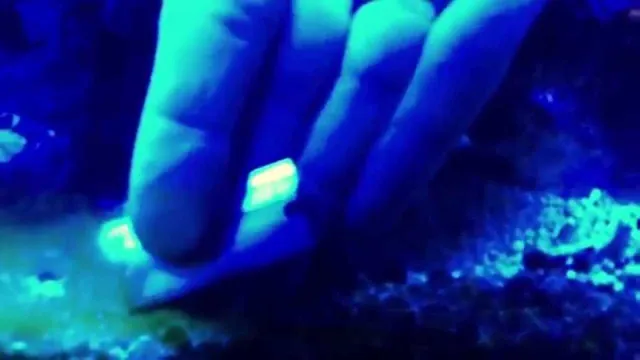
Causes of Algae Buildup
Algae buildup can be frustrating for pond owners because it can happen despite their best efforts to prevent it. Algae thrive in sunlight, so ponds that receive a lot of sun exposure are more susceptible to algae growth. Additionally, high levels of nutrients in the water, such as nitrogen and phosphorus, can fuel algae growth.
Runoff from nearby farms or lawns can contribute to excess nutrient levels. Changes in temperature and pH level can also encourage algae. A lack of circulation in the water can trap algae and cause it to accumulate in stagnant areas of the pond.
To prevent algae buildup, it is important to regularly clean the pond and remove excess debris. Adding plants to the pond can also help absorb excess nutrients and provide shade to limit sunlight exposure.
Prevention Tips to Avoid Algae Buildup
If you’re struggling with algae buildup in your saltwater aquarium, there are a few prevention tips you can follow to keep your glass looking clean and clear. First, avoid overfeeding your fish, as excess food can contribute to algae growth. Additionally, make sure to clean your aquarium regularly, removing any debris or waste that could feed algae.
You can also consider adding algae-eating fish or snails to your tank, which can help keep the algae population under control. And if you do notice algae starting to form on your aquarium glass, there are a few ways to clean it safely and effectively. One method is to use a scraper specifically designed for aquarium glass, gently removing the algae without scratching the surface.
Another option is to use a vinegar solution, which can help break down and dissolve the algae, making it easier to wipe away. By following these prevention tips and knowing how to safely clean algae from your saltwater aquarium glass, you can keep your tank looking beautiful and healthy for your aquatic pets. (See Also: Maximizing Your Aquarium’s Health: How to Add More Water to Aquarium Properly)
Regular Water Changes
Algae buildup can be a common issue in any aquarium. However, there are some simple prevention tips you can follow to ensure that your tank stays clean and healthy. One of the most important tips is to regularly change the water.
This not only removes any excess algae and other debris but also replenishes the essential nutrients and minerals that your fish need. Aim for at least a 10% water change each week, and make sure to use a good quality water conditioner to protect your fish from any harmful chemicals. Additionally, incorporating live plants can help absorb excess nutrients that algae feed on, further preventing buildup.
Taking these steps can ensure that your aquarium stays clean and healthy for both your fish and your enjoyment.
Avoid Overfeeding
Overfeeding is a common mistake among fish owners, one that can lead to serious issues with algae buildup in your aquarium. If you’re adding too much food, uneaten bits will sink to the bottom, contributing to a nutrient-rich environment that promotes algae growth. To prevent this from happening, it’s important to get into a routine of feeding your fish appropriate portions.
Avoid throwing in large amounts of food at once and instead, give small amounts throughout the day. Observe your fish and see how much they eat in a few minutes. Only feed them what they need, so there’s no excess food to decay and create an algae problem.
Keeping your tank clean and reducing your feeding can also help, especially for those who are dealing with stubborn algae growth. With a little bit of care and attention, you can manage your aquarium and keep it looking pristine.
Control Light Exposure
One effective way to prevent algae buildup in your aquarium is by controlling the amount of light exposure your tank receives. Algae thrive on light, so limiting the amount of light that reaches the water can keep their growth in check. An excellent way to achieve this is by placing your aquarium in a location that does not receive direct sunlight.
If this is not possible, consider using light-dimming solutions like aquarium hoods or covers that reduce the amount of light that enters your aquarium. Moreover, you can also regulate the length of time your aquarium light is on. Algae grow faster under prolonged exposure to light, so it’s best to maintain a consistent lighting schedule of 8-10 hours per day and avoid overexposure.
By controlling light exposure, you can prevent unwanted algae growth and keep your aquarium clean and healthy.
Removing Algae from Glass
Keeping your saltwater aquarium clean and healthy is one of the most important aspects of fishkeeping, which is why it’s crucial to remove algae from the glass regularly. To do this, you’ll need a scraper specifically designed for aquariums, as well as a bit of elbow grease. Start by scraping the sides of the tank, working in a circular motion and being careful not to scratch the glass.
Next, use a toothbrush to scrub away any remaining algae, especially around corners and edges that can be difficult to reach with a scraper. Finally, use an aquarium-safe cleaning solution to wipe down the glass and remove any stubborn stains or marks. With a little effort and the right tools, you can keep your aquarium looking clear and beautiful for your fish to enjoy.
Equipment Needed
When it comes to removing algae from glass, you’ll need a few essential tools to get the job done right. Firstly, a good quality algae scraper is a must-have item. Look for a scraper with a comfortable grip and a blade that won’t scratch your tank.
Secondly, a cleaning pad is also essential. Make sure you get a pad that is safe for use on glass to avoid any damage. Finally, a bucket and some aquarium-safe cleaning solution will help you carry out the task. (See Also: How to Make Aquarium Drain Quieter: Tips and Tricks for a Peaceful Environment)
Remember, before you start cleaning, always ensure that your aquarium is empty of fish or any other creatures that may be affected by the solution. With the right equipment, removing algae from glass can be a breeze!
Step-by-Step Process
One of the most common problems in maintaining an aquarium is the presence of algae on the glass walls. But don’t fret – removing algae is a simple process that can be done in just a few easy steps. First, turn off all equipment to prevent any cleaning chemicals from being inadvertently sucked into filters or pumps.
Next, use a scraper or a pad to remove as much algae as possible from the glass. Be sure to scrape gently to avoid scratching the glass. Then, take a clean cloth and dip it in a solution of hydrogen peroxide or vinegar.
Use this to wipe down the glass, removing any remaining algae or residue. Finally, rinse the glass thoroughly with clean water. Voila! Your aquarium glass is now crystal clear and free from pesky algae.
Keep up with regular maintenance to avoid algae buildup in the future.
Maintenance and Ongoing Prevention
If you’re an aquarium owner, you know the importance of keeping your tank clean and healthy. One common problem that arises is algae growth on the glass of a saltwater aquarium. To clean algae from a saltwater aquarium glass, you should start by using a scraper or brush to remove as much of it as possible.
Then, manually wipe the glass with a cloth or sponge. You can also use a specialized cleaning solution, but make sure it’s safe for your specific tank inhabitants. But cleaning alone is not enough.
To prevent algae growth from happening in the future, you need to maintain a proper balance of nutrients and light in the tank. This involves regular water changes, controlling the amount of light the tank is exposed to, and ensuring that you don’t overfeed your inhabitants. Consistent maintenance and prevention will keep your aquarium looking its best and prolong the health and longevity of its inhabitants.
Regular Cleaning Schedule
Maintaining a regular cleaning schedule is an important aspect of keeping any space clean and healthy. Whether it’s a home, office, or other environment, cleaning should be done on a regular basis to prevent the buildup of dirt and germs. Regular cleaning can help prevent the spread of illness and improve the overall appearance of a space.
One of the best ways to prevent dirt and grime from building up is to establish a regular cleaning schedule. This should include daily tasks like wiping down surfaces and vacuuming, as well as weekly tasks like dusting and sanitizing. By doing this, you can keep your space looking and feeling clean and maintain a healthy environment for the people who use it.
The key is to stick to the schedule and make cleaning a regular habit. By doing so, you’ll be able to keep your space in top condition and avoid the need for more intensive cleaning or repairs in the future. So, don’t delay, start your regular cleaning schedule today and enjoy a clean, healthy space!
Monitor Water Quality
Maintaining clean and safe water quality is essential for the health and well-being of both humans and aquatic life. Regular monitoring of water quality is crucial for detecting any potential contaminants, such as bacteria, chemicals, or pollutants, that could harm the eco-system. It’s important to also take into consideration any external factors, like climate change or changes in land use, which could impact the quality of the water.
By maintaining a consistent monitoring schedule, you can prevent harmful toxins from reaching the water supply and prevent potential risks to public health. By treating the water regularly, you can avoid harmful chemicals and pollutants from seeping into your drinking water supply. Overall, regular testing and preventive measures remain critical for the continued protection of aquatic life and the safety of our water sources.
Observe Tank Inhabitants
To ensure the long-term health and happiness of your tank inhabitants, it’s essential to pay close attention to maintenance and ongoing prevention. This means observing your fish and plants regularly and taking action if you notice any signs of distress, such as changes in behavior or appearance. Keep a close eye on water conditions, too, monitoring parameters like pH, temperature, and ammonia levels to ensure they remain within safe ranges. (See Also: How to Design a Aquarium in Sketchup: Step-by-Step Guide for Beginners.)
Regular water changes are also essential to remove harmful toxins and waste products. In addition to these proactive measures, it’s essential to keep an eye out for any potential problems and address them promptly. By being proactive and diligent, you can provide the best possible living environment for your tank inhabitants, helping them thrive for years to come.
Conclusion
In the end, cleaning algae off of your saltwater aquarium glass is like removing a stubborn stain from your favorite shirt. But with the right tools, technique, and perseverance, you can make your aquarium shine like new again. So grab your scraper, put on some tunes, and channel your inner marine biologist.
Happy cleaning!”
FAQs
What causes algae to grow on saltwater aquarium glass?
Algae growth is typically caused by excess nutrients in the water, such as phosphates and nitrates.
How often should I clean the glass in my saltwater aquarium?
It is recommended to clean the glass at least once a week to prevent algae buildup.
What tools do I need to clean algae from saltwater aquarium glass?
You will need an algae scraper, a razor blade, a microfiber cloth, and a bucket.
Can I use bleach to clean my saltwater aquarium glass?
No, bleach can be harmful to fish and other aquatic life. Use an aquarium-specific cleaner instead.
How do I prevent algae from growing on my saltwater aquarium glass?
Proper maintenance, including regular water changes, controlling nutrient levels, and proper lighting, can help prevent algae growth.
Can I use vinegar to clean my saltwater aquarium glass?
Yes, a mixture of water and vinegar (in a 3:1 ratio) can effectively clean algae from aquarium glass.
What is the best way to clean hard-to-reach areas of the aquarium glass?
Using a razor blade or an alga scraper with an extendable handle can help reach difficult areas for thorough cleaning.

